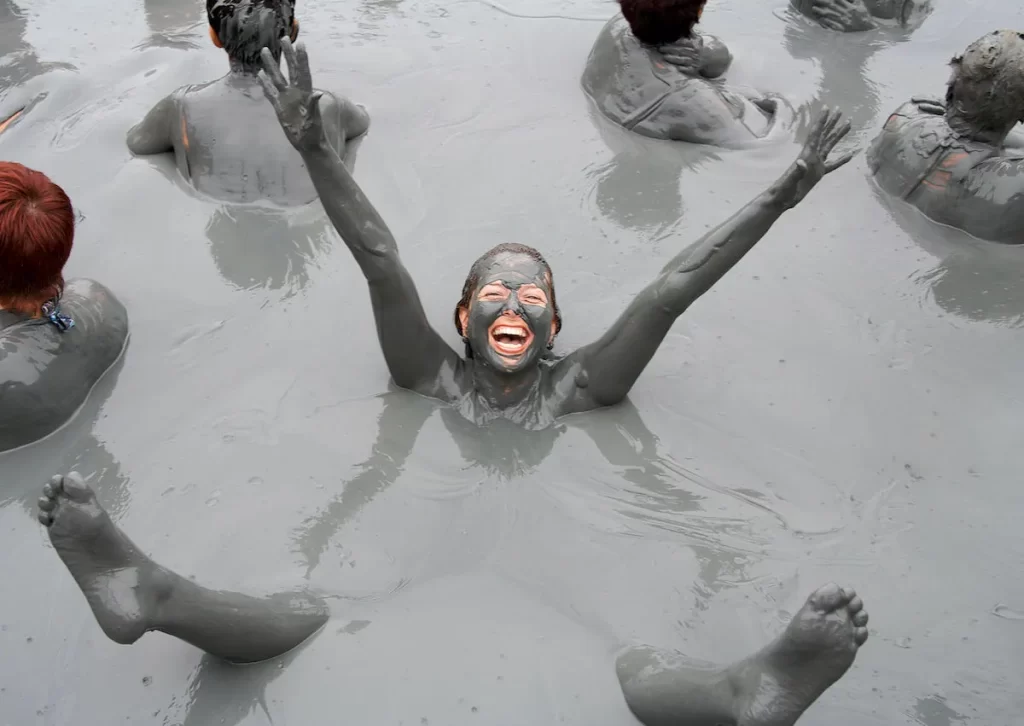Mud Bathing: Nature’s Purest Spa
The earth beneath our feet, often overlooked in our daily hustle, holds ancient secrets to rejuvenation and healing. One of such secrets is the therapeutic wonder of natural mud baths. From steaming volcanic ash pools to the dense, mineral-rich marshes, the world is dotted with nature’s own spas that have been a haven for wellness seekers for centuries.
The Origin of Mud Bathing
The history of mud bathing can be traced back to ancient civilizations. The Romans, known for their elaborate bathhouses, often incorporated mud treatments into their routines. Similarly, various indigenous tribes around the world have long recognized the curative properties of earth and mud, using them in rituals and treatments.
Volcanic Ash Pools: Nature’s Hot Tubs
Located near active volcanic regions, these ash pools are a blend of volcanic soil, minerals, and organic matter. The high temperature of these pools, combined with the rich mineral content, offers a detoxifying experience. The silica and sulfur in the mud can exfoliate and nourish the skin, leaving it feeling refreshed and revitalized.
Volcanic ash pools, also known as geothermal pools or hot springs, are found in regions with volcanic activity. These pools are heated by the Earth’s natural geothermal energy and often contain a rich mix of minerals. Here’s a list of some renowned volcanic ash pools and hot springs from around the world:

- Blue Lagoon, Iceland: One of the most famous geothermal spas, its milky-blue water is rich in silica and sulfur.
- Hellsgate, New Zealand: Known as the geothermal wonderland, Rotorua offers numerous hot springs, mud pools, and geysers.
- Onsen, Japan: Japan boasts thousands of onsens, or natural hot springs, with many of them located in volcanic regions like Beppu, Hakone, and Noboribetsu.
- Yellowstone National Park, USA: Home to the Grand Prismatic Spring, among other geothermal features.
- Tuscany, Italy: The region has several natural hot springs, like Saturnia, known for their therapeutic properties.
- Arenal, Costa Rica: Located near the Arenal Volcano, the region has several hot springs resorts.
- Deildartunguhver, Iceland: Europe’s most powerful hot spring.
- Glenwood Springs, Colorado, USA: Known for its large mineral hot springs pool.
- Pamukkale, Turkey: Famous for its terraces of carbonate minerals left by flowing water.
- Banff Upper Hot Springs, Canada: Located in the Rocky Mountains, it offers a picturesque setting for relaxation.
- Valley of Geysers, Kamchatka, Russia: One of the largest geyser areas in the world with numerous hot springs.
- São Miguel, Azores, Portugal: Famous for its geothermal pools, especially in Furnas.
- Calistoga, California, USA: Known for its mud baths and hot springs.
- Grutas de Tolantongo, Mexico: A collection of hot springs on cliffs and caves.
- Ma’in Hot Springs, Jordan: Situated between Madaba and the Dead Sea, these hot springs are known for their therapeutic properties.
Marshes and Mineral-Rich Muds
Unlike the warmth of volcanic ash pools, marsh muds are often cool and dense. Found in wetlands, these muds are a cocktail of organic matter, minerals, and therapeutic gases. The high concentration of magnesium, calcium, and other minerals can aid in alleviating skin conditions like psoriasis, eczema, and even acne.

Marshes, wetlands, and bogs have long been recognized for their therapeutic muds, which are rich in minerals and organic compounds. While not as widely commercialized as volcanic ash pools, many marshes and wetlands around the world offer mud bathing experiences. Here’s a list of some well-known marsh mud baths and related sites worldwide:
- Dead Sea, Israel and Jordan: While not a marsh, the Dead Sea’s mineral-rich mud is renowned for its therapeutic properties and has been a spa destination for centuries.
- Peloid Complex, Tuzla, Bosnia and Herzegovina: Home to therapeutic salt lakes and muds that are beneficial for various ailments.
- Enez, Turkey: This region has salt marshes known for therapeutic mud baths.
- Lake Elton, Russia: A salt lake with therapeutic muds that have been used for spa treatments.
- Sultaniye Hot Springs, Turkey: Located near Lake Köyceğiz, these springs offer both thermal waters and therapeutic muds.
- Techirghiol Lake, Romania: Famous for its salty mud baths, which are believed to have healing properties.
- Ras El Ma, Morocco: This region is known for its hot springs and mud with therapeutic properties.
- Fango, Italy: The island of Ischia in the Gulf of Naples is famous for its ‘fango’ or therapeutic mud.
- Lagoon of Mar Menor, Spain: The mud baths here are believed to be beneficial for a variety of skin and joint problems.
- Dalhousie Springs, Australia: Located in Witjira National Park, these springs offer warm waters and therapeutic muds.
- Kunashir Island, Russia: Located in the Kuril Islands, the mud here is believed to have therapeutic properties.
- Heviz, Hungary: While famous for its thermal lake, the region also offers mud treatments with therapeutic benefits.
- Nin, Croatia: Known for its medicinal mud (peloid) which is used for therapy and rehabilitation.
- Lake Urmia, Iran: This salt lake’s mud is believed to have therapeutic properties.
- Laguna Salada de Torrevieja, Spain: This pink salt lake offers mud baths that are popular among tourists for their supposed skin benefits.
The Skin Benefits of Mud Bathing
Mud, in its various forms, offers a plethora of benefits for the skin:
- Detoxification: The dense texture of mud helps in drawing out impurities and toxins from the skin.
- Exfoliation: The fine particles in mud act as a natural exfoliant, removing dead skin cells and promoting cell regeneration.
- Moisturization: Many mud types have natural oils and minerals that hydrate the skin, leaving it soft and supple.
- Anti-inflammatory Properties: Elements like sulfur and magnesium in mud can reduce inflammation, making it beneficial for people with inflammatory skin conditions.
Eco-Responsibility While Mud Bathing
While the allure of natural mud baths is undeniable, it’s essential to approach them with a sense of eco-responsibility. These natural spas are delicate ecosystems. Always ensure you’re not introducing harmful chemicals (from lotions or sunscreens) into the environment. When visiting these sites, be respectful, and avoid disturbing the natural habitat.


